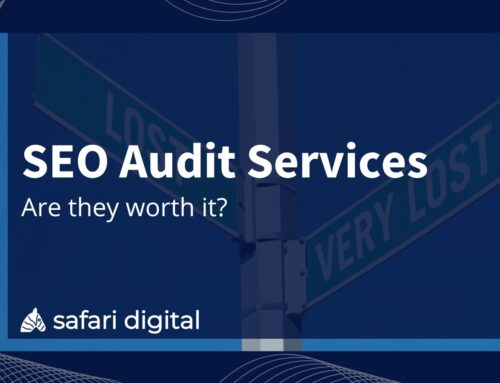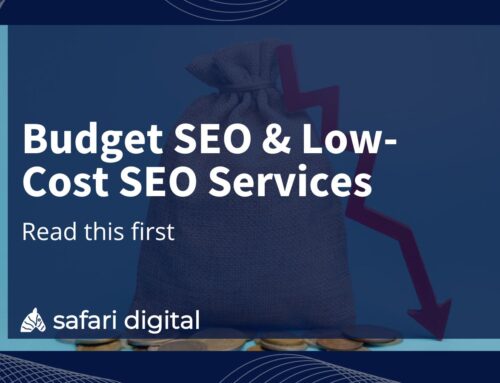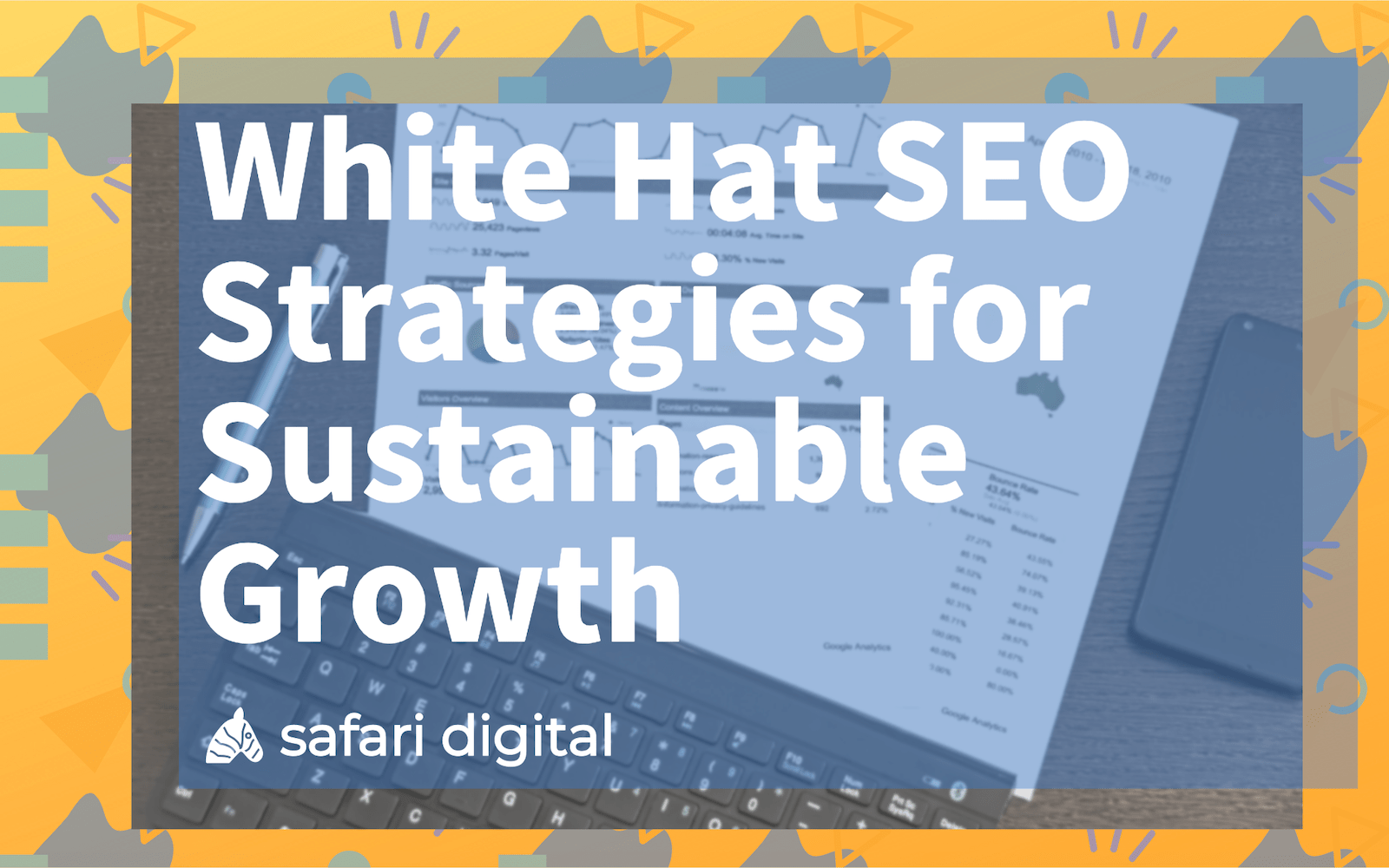
Your guide to playing by Google’s rules, and coming out on top with white hat SEO.
Well before the Penguin updated released by Google, there were plenty of shady techniques that could be used to obtain legitimate SEO results. However, in the years since, Google has been consistently finding ways to weed out those using black hat SEO tactics and penalise them for going against their guidelines.
Today, short-sighted, low quality and “spammy” SEO tactics can result in having your site completely stripped from search engine rankings.
Recovering from these nasty Google penalties can take years, and ultimately destroy your online presence.
Additionally, using black hat SEO tactics can make for a low quality, spammy and misleading user experience.
The infamous Penguin update was triggered by unethical black hat techniques including low quality backlinks, keyword stuffing, and link scheming. The update kickstarted a much-needed significant shift in the SEO community from conditional search engine visibility to long term, sustainable SEO strategies.
While black hat tactics may still provide immediate results; the difference being that today, these results will never be sustained with Google’s clever algorithm.
We’re all here to objectively set out on the same mission: to beat Google at its own game. And if history has taught us anything, Google hates it when we break the rules. So, how do we find SEO success while sticking to their guidelines?
White hat SEO.
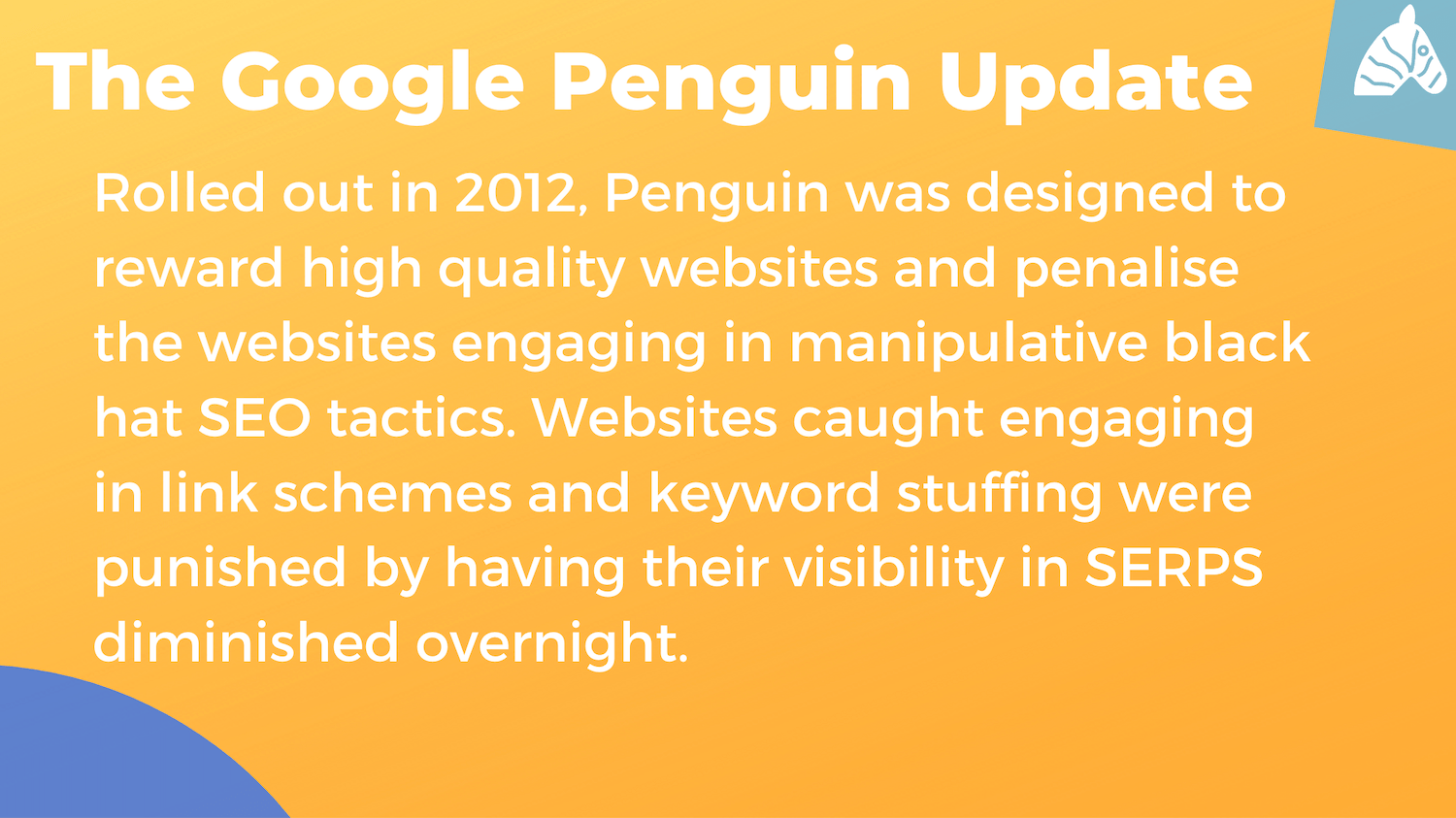
We’ve created this article to comprehensively separate black and white hat SEO techniques and discuss the best white hat practices that will help you attract more traffic, increase rankings, and improve your conversion rates.
Let’s first take a look at the differences between white hat SEO and black hat SEO.
White Hat SEO vs. Black Hat SEO
The key difference between black and white hat techniques is their respective approaches to SEO. Both camps are pining for the same goal; to improve a website’s standing in the search results. However, the way they each go about SEO is very different.
Search Engine Optimisation is all about optimising and manipulating a website to change the way it is read and interpreted by search engines. Sure, it has a lot to do with search engine visibility – but rankings are not the be-all and end-all of SEO.
White hat is generally known for approaching SEO with tactics that fall in line with search engines’ terms of service.
Google is pretty clear about their priority is putting the user’s experience first. White hat SEO is based around following Google’s guidelines, and building an SEO strategy around Google’s main priorities.
When you follow the guidelines, you’re killing two birds with one stone – creating a user experience that will work for humans while also keeping in Google’s good books. These two factors in combination will not only give your target audience a valuable, insightful experience, but will additionally lead to higher search rankings and ultimately, more conversions.
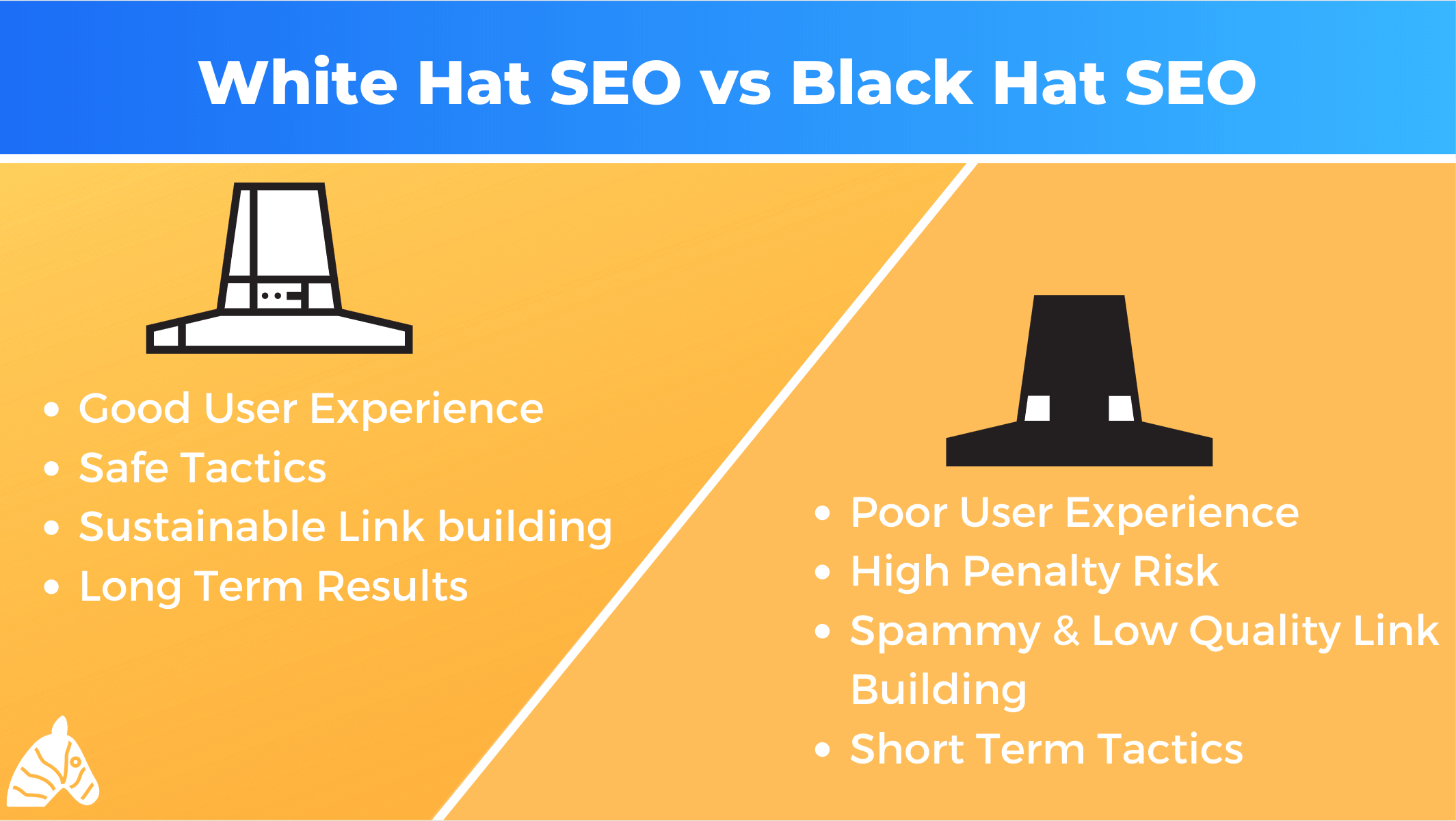
Black hat SEO is essentially the opposite of white hat SEO. Black hat techniques are notorious for being spammy, low-quality and short sighted.
These techniques include everything that is considered to be deceitful, harmful or shady. Some of the more well-known examples of black hat SEO include keyword stuffing, sneaky redirects and low-quality link building.
Black hat SEO tactics used to be legitimate ways to grow online presence, and initially, they will work. They can actually provide skyrocketing rankings and unbelievable immediate visibility.
Here’s the catch: The results from Black hat SEO tactics will never last.
These strategies are low quality, spammy, and will never be sustained. This is because Google’s algorithm is constantly catching up and is only becoming smarter with each update. As Google continues to catch on to dirty black hat SEO tactics, their management strategy is to hand out penalties.
If you decide to use black hat SEO tactics, sooner or later, you can expect a Google penalty. The more penalties your website receives, the harder it will be to get your site clean and visible in search engine rankings again. Recovering your website from a penalty can be a long, drawn out, and expensive process.
The sum and substance of the age-old debate between black and white hat SEO is that while they both include strategies that will increase search visibility, the risk associated with black hat tactics is far too high and not sustainable. If you’re after long-term business growth, white hat SEO is the way to go.
Now that we’ve cleared that up, let’s focus on some white hat SEO strategies that every business should be implementing.
Implementing Basic White Hat SEO Strategies
White hat SEO doesn’t have to be complicated. It’s as simple as following guidelines and finding ways to enhance visibility and optimising your website without any deceit. Here are a few ways you can implement white hat SEO today.
1. Work to improve user experience
The type of user experience you provide to your website visitors is an important factor for Google. In fact, Google have been putting more emphasis on the importance of user experience with each update to their algorithm. The search engine algorithms are designed to reward those who provide a smooth and pleasurable user experience.
Google’s main mission is to serve users with the best quality content on any given subject. By focusing on user experience, you’re not only pleasing Google, but you’re also creating an enjoyable experience that will have visitors coming back.
Too many marketers focus their efforts on trying to construct content for bots – a common misstep in search engine optimisation. The key to effective SEO is intertwining optimisation and UX (User Experience).
Without SEO, your website will receive no traffic. Without UX, your search engine rankings will suffer, and your website will have trouble converting any incoming traffic.
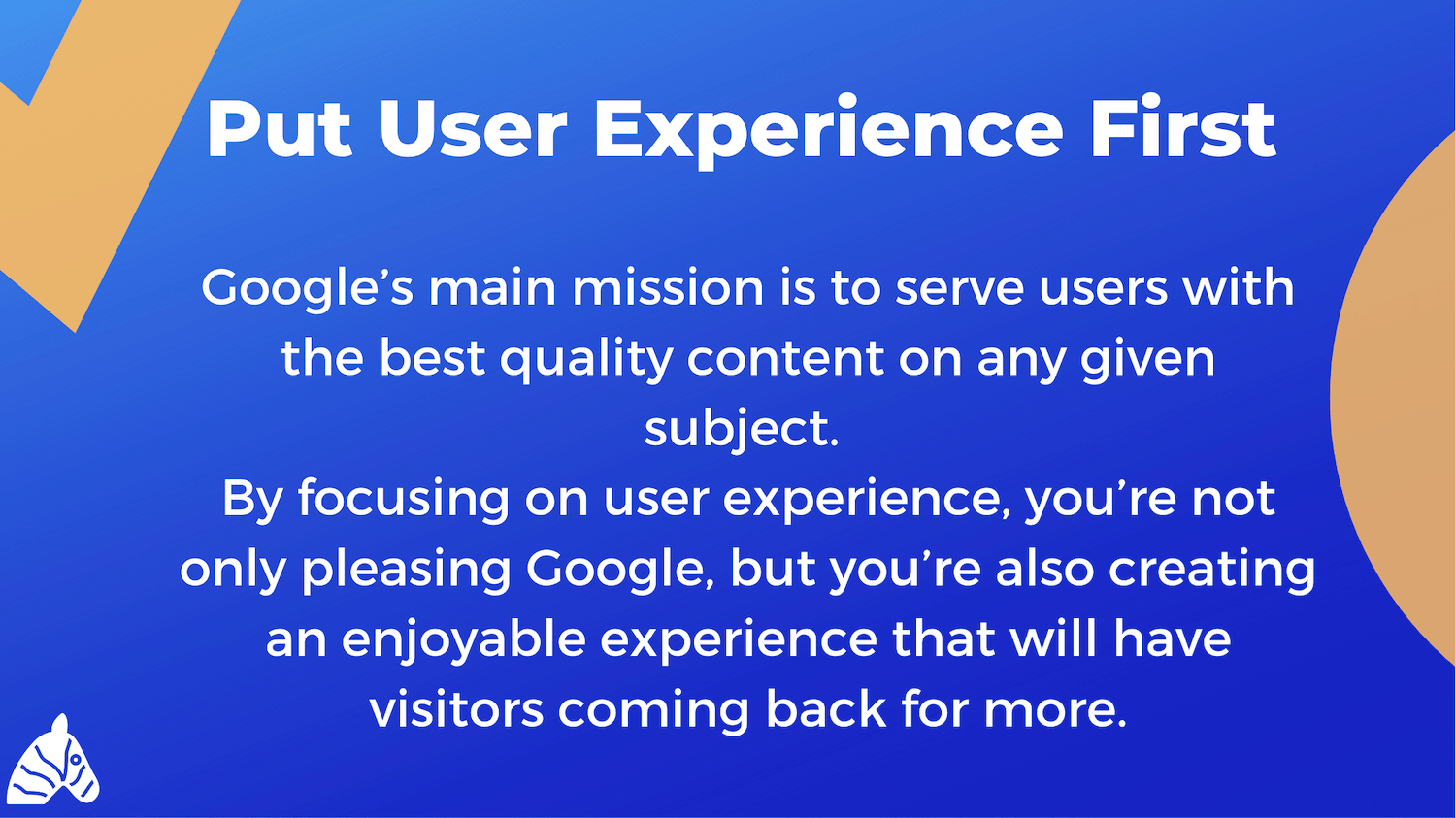
Put User Experience first by working on these factors:
Website Navigation
Effective navigation design is crucial for smooth and enjoyable user experience. Good navigation makes it easy for visitors to interact with your website and quickly find what it is they are looking for.
The easier your site is to navigate, the easier it will be for search engines to crawl. Crawlers will follow the webpages and links on the site, much like a visitor would. Good website navigation will offer a smooth crawling experience for search engines, making it easier for them to understand and determine the purpose of your pages.
Find a reputable and trusted web developer to improve the layout of your website. Ultimately, effective website navigation will result in greater search visibility and increased conversions.
Site Speed
The speed and performance of your website is both a ranking factor for Google, and an important factor for user experience.
Users hate waiting for slow websites to load. The latest SEO data compiled in 2019 revealed that mobile sites that took longer than 5 seconds to load have a 70% lower mobile session rate than those that load in under 5 seconds.
According to Google, a delay in site speed of one second can mean a 20% drop in conversions.
Speeding up your site is one of the easiest ways to enhance user experience and please search engine algorithms. You can test the speed of your desktop and mobile websites using the free Google PageSpeed Insights tool.
Make Your Website Mobile Friendly
Did you know that 60% of all Google searches are now done through a mobile device?
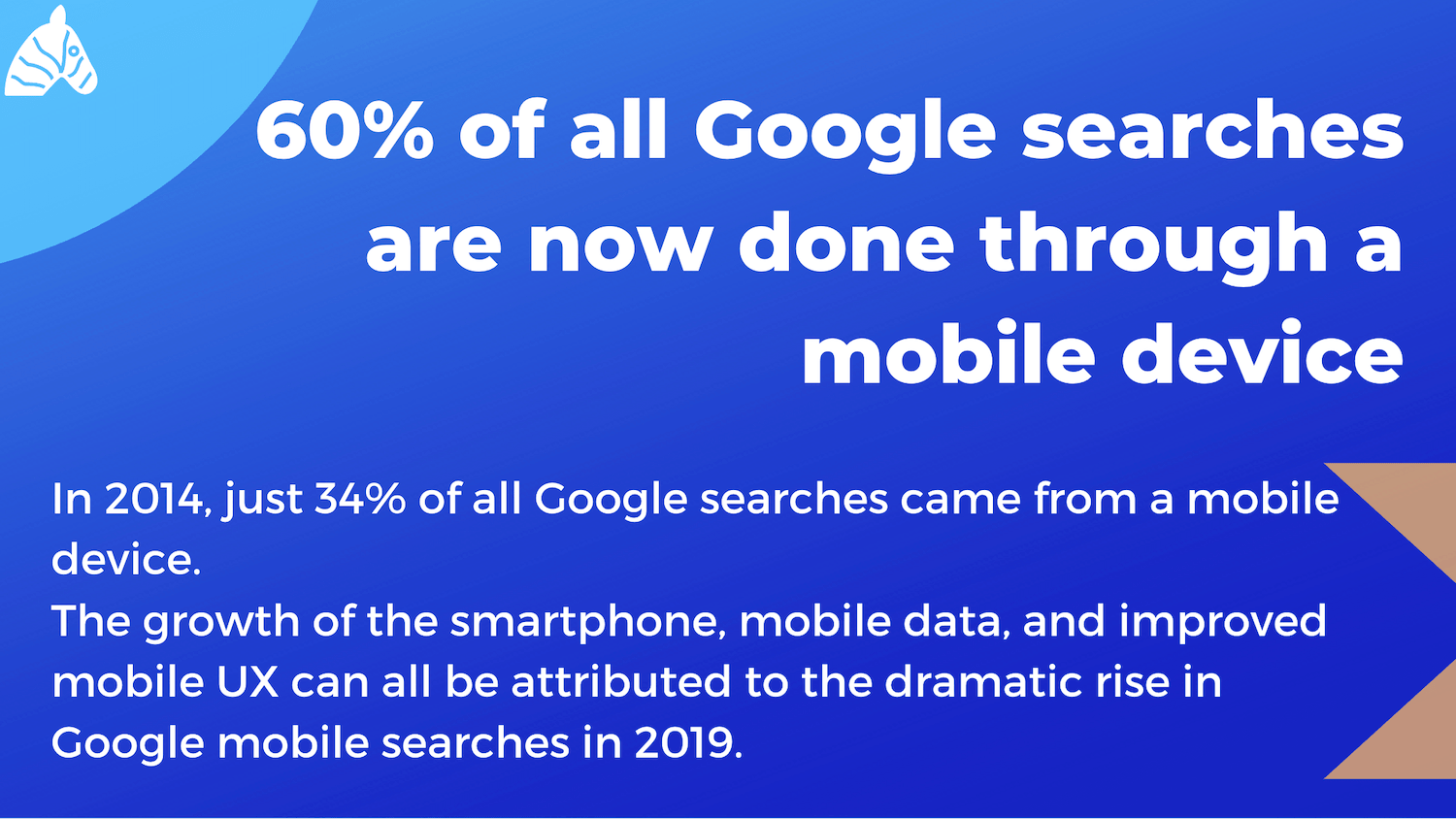
That means that if your website is not mobile friendly, you’re missing out on huge opportunity to provide a smooth user experience for searchers.
A mobile friendly website means that you can reach a wider audience. Responsive websites make sharing simple, and so website visitors are more likely to share your content on their social platforms. Plus, mobile-friendliness has been a ranking factor for Google since 2015 – websites that have been optimised for mobile use take preference over those which are non-responsive.
User experience is something that is not touched on with black hat SEO. And yet, it is one Google’s largest concerns. Work to improve your user experience, and you will be rewarded by both Google and those who are visiting your site.
2. Keyword research
Talk to any marketer and they’ll tell you the same thing: Keywords provide the foundation for search engine optimisation.
Keywords are the themes, topics and ideas that a piece of content are based upon.
It wasn’t all that long ago that the basis of SEO was finding the target keywords for a search query, and loading them into a web pages meta tags, visible content, and backlink anchor text. Prior to updates in 2014, this was a legitimate way to score search engine visibility. In fact, this is still a commonly used black hat SEO tactic.
Today, Google’s algorithm is far too clever for keyword stuffing. It can now pick up on language nuances included synonyms, stemming, and answers to questions. This means that for white hat SEO, your keyword usage needs to be smarter too.
Keyword research will give you an idea of what users are looking for. This will help you to understand and choose the themes and content topics for articles, how-to-pieces, informative videos and long-form content.
Once you’ve established your target keywords and phrases, avoid stuffing them in places that are not natural or organic. To benefit from the use of keywords, include them in some of the key spots of each web page:
- Article title, page title and meta tags
- Article subheadings
- First paragraph of the article
- URL slug
Including your keywords in these elements of the webpage will help to: engage and attract readers that are searching for that specific term and help search engines easily determine the purpose of your article.
3. Create informative and unique content
Creating authentic, informative and valuable content is one of the main pillars of white hat SEO. After all, white hat SEO is all about working with Google’s guidelines, and providing unique and valuable content universally is what Google strives for.
A comprehensive content marketing strategy will focus on creating engaging content that will draw your readers in and keep them coming back for more. Websites with good engagement signals will be rewarded in search engine rankings and will benefit from increased traffic.
Stealing, copying and creating low quality, jargon-filled content are all examples of black hat SEO. Not only is it unethical to republish existing posts without attribution, Google sees duplicate content as a signal for a poor-quality website.
Both Google and your readers appreciate unique, educational and trustworthy content. While stealing and re-purposing someone else’s article might save time, it will get you nowhere.
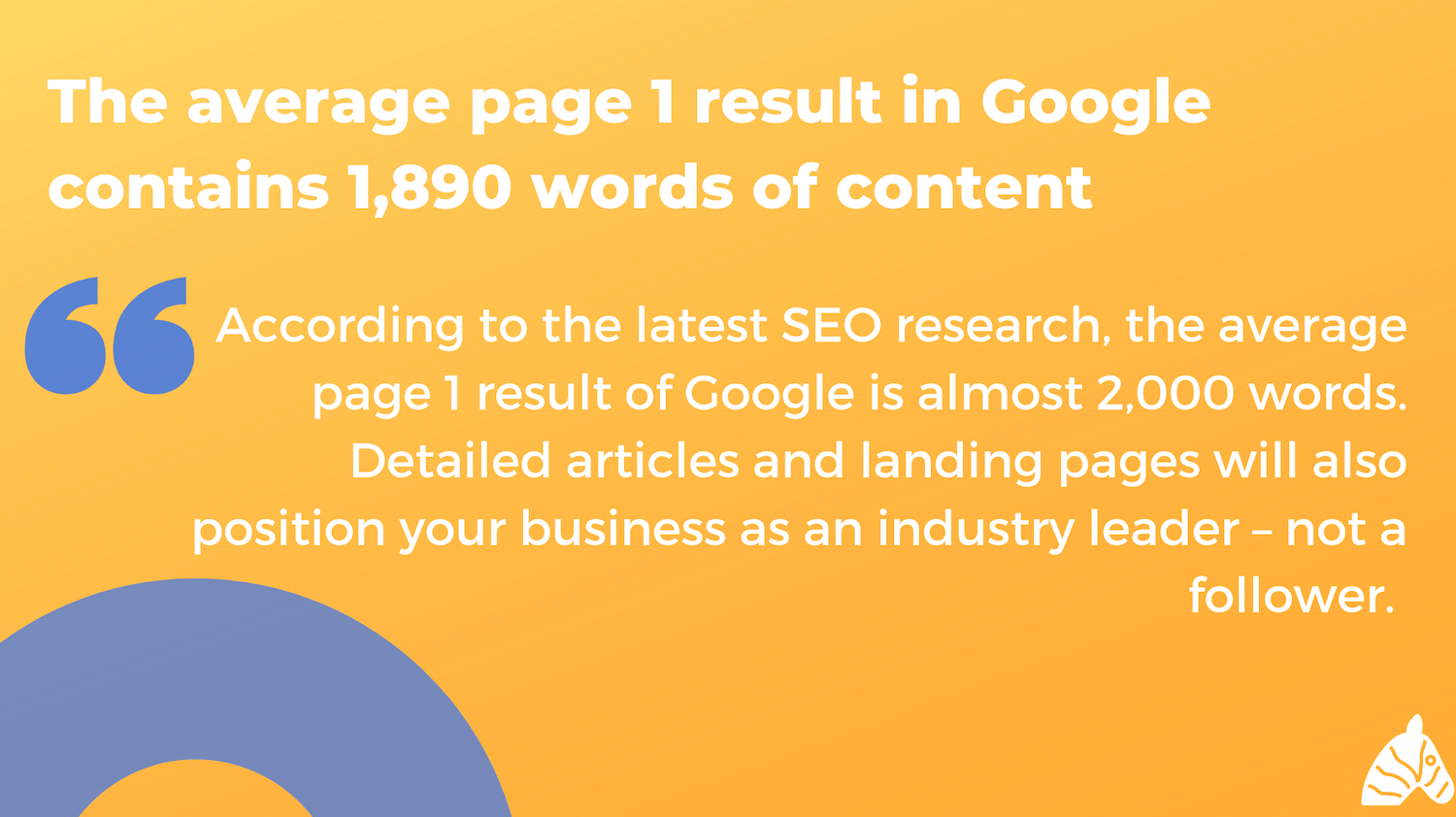
Informative and educational content that covers an entire topic on one page will rank well. The more in-depth and valuable the content, the more your readers will find it useful. The longer and more educational the content, the more search engines will like it.
When a reader comes across your content and finds it useful, insightful and valuable, they are more likely to return to your website later on. Google loves informative and unique writing that can provide assistance to users.
This has resulted in a strong correlation between in-depth, lengthy content and search engine rankings. Detailed articles and landing pages will also position your business as an industry leader – not a follower.
The bottom line is, creating unique and informative content is a huge part of white hat SEO – one that cannot be skipped.
4. Sustainable Link Building
A huge differing factor between white hat SEO and black hat SEO is the approaches to link building. Black hat SEO focuses on high quantity, low quality backlinks for short-sighted results, whereas white hat SEO focuses on high quality, sustainable link building efforts.
Link building is not something you can afford to skip over. The strength of a link building strategy is by far the largest element is Google’s ranking algorithm. It’s something that takes a lot of time and patience, however, when done correctly, the efforts are rewarded with high visibility that is long lasting.
Buying and selling links directly violates Google’s guidelines. Participating in link schemes can negatively impact a site’s rankings and result in being penalised by Google.
White hat link building involves a long-term strategy that focuses on quality, relevancy, and natural growth.
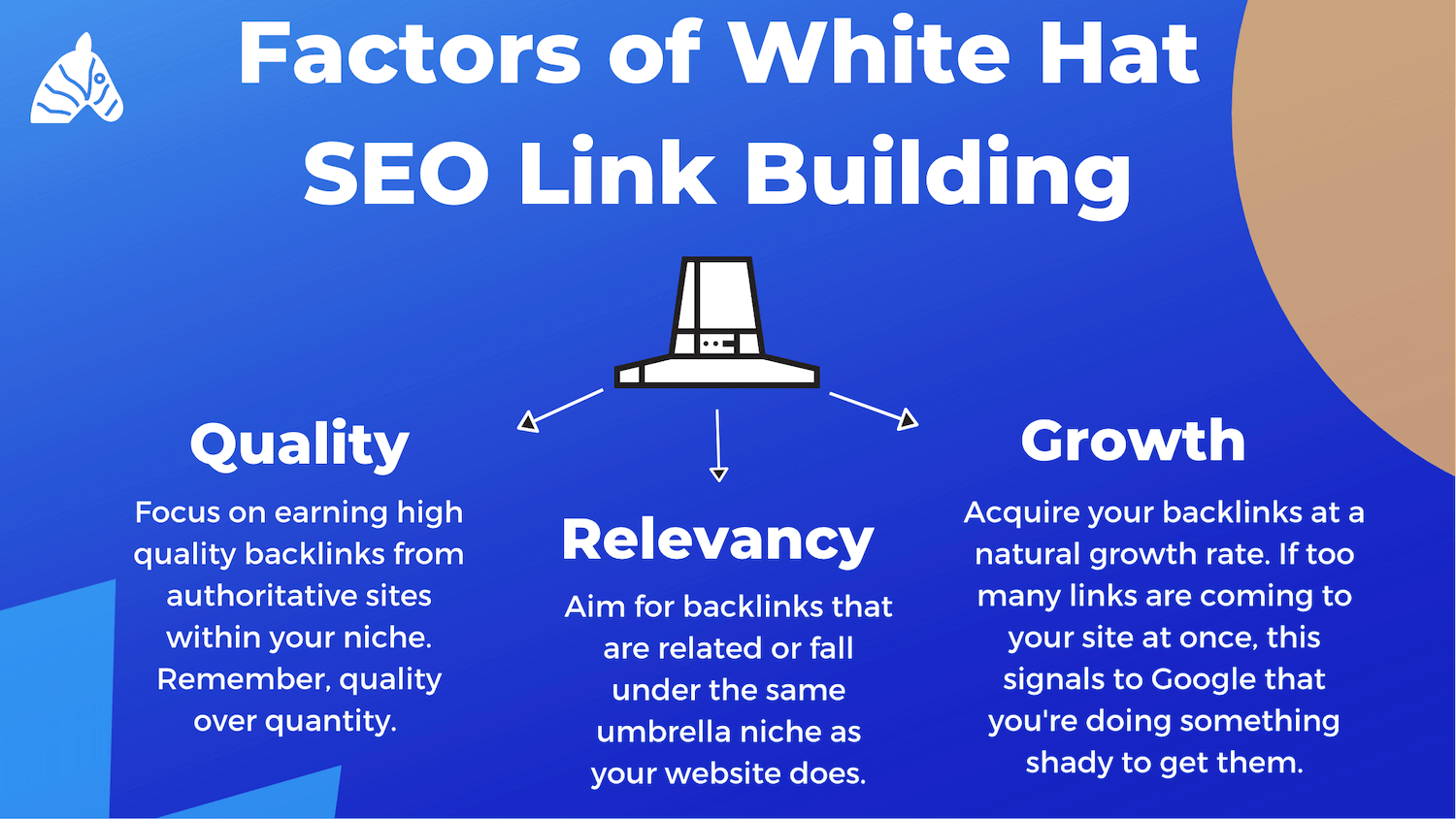
One high quality links is much more effective than twenty low quality links from a spammy website. Focus on earning backlinks from authoritative sites within your niche that have proven to be trustworthy and well-known sources.
Backlinks that are relevant to your website are much more valuable than random links. Aim for backlinks that are related or fall under the same umbrella niche as your website does.
It’s important to have backlinks coming into your site at a natural growth rate. If Google can see that you’re acquiring a lot of backlinks over a short period of time followed by nothing, this signals to them that you’re likely buying them.
Link building is one of the most difficult and time-consuming aspects of SEO. However, just because it takes a long time doesn’t mean it should be forgotten. In fact, with enough time and patience, link building can become one the most sustainable and lucrative opportunities for online growth.
On-Site White Hat SEO
Last but not least, the final white hat tactic to implement is on-site SEO. This one is a little broad, considering how many on-page tweaks and adjustments that can be made for optimisation. However, we’ve compiled a few crucial elements of on-site white hat SEO that we think are the important as starting point.
These little adjustments and changes can create large and sustainable impacts.
1. Internal linking
Internal linking is an architectural tactic that is often forgotten. Many marketers don’t realise the importance and value of linking in between your pages within your website.
For one, every internal link creates a path for Google to follow. This helps the crawlers understand your content and site architecture.
Not only does it help connect each piece of content, but internal linking also sends authority to those pages that you want to rank better. The internal links allow users to navigate a website, and they help to establish information hierarchy within the website.
2. Keyword Rich URLs
When creating your URLs, focus on including keywords and keeping the URL short and simple.
Google uses this information to determine what your content is about, so make your URLS both concise and keyword rich. This way, search engines know exactly what the purpose of the content is, and how to appropriately index it.
3. Use alt tags for images
Search engines can’t see your images – they can only read them. Help Google figure out the purpose of your image by using alt tags to describe the image.
The more descriptive and accurate your alt tags are, the better understanding Google will have of them to index.
Images are one of the best ways to enhance user experience and make content attractive. Using alt tags is the best way to optimise your images.
4. Optimise meta-tags
Create your meta descriptions for each page with keyword-rich, descriptive writing. This will enable both users and search engines to find your content more easily and summarise the purpose of the page.
While meta data isn’t as important for SEO rankings as it used to be, the meta description plays a significant role in on-page SEO.
Conclusion
White hat SEO is the use of optimisation techniques that are aligned with Google’s guidelines. If you want to know how to beat Google at its own game, sneaky tricks and shady black hat tactics will not do you any favours.
Instead, you should be focusing on what Google would do, and how you can implement that thinking.
Google’s main goal is to put its users first and serve the highest quality information. So, what do you need to do?
- Offer superior user experience
- Create unique and valuable content
- Build high quality and long-term links
Not only do white hat SEO strategies create a good standing point for your website with Google, but they also provide long-term and sustainable results. Investing in white hat SEO tactics will be the difference between a short-term win, and a long-term successful website. Need help with your SEO? Safari Digital SEO specialists can help your business attract new leads through search engine optimisation. Get in touch to find out how we can grow your business.



